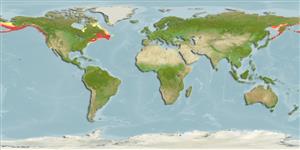Environment: milieu / climate zone / depth range / distribution range
Ecology
Marine; brackish; benthopelagic; oceanodromous (Ref. 51243); depth range 0 - 275 m (Ref. 58426), usually 30 - 100 m (Ref. 56557). Temperate; 63°N - 32°N, 145°E - 21°W (Ref. 57358)
Arctic, Northwest to Northeast Pacific: Arctic Alaska to the Sea of Japan and Balboa Island, southern California, USA. Western Atlantic: northern Quebec, Canada to North Carolina, USA. The Arctic and Pacific populations may be a separate species, distinct from the Atlantic populations (Ref. 7251).
Length at first maturity / Size / Weight / Age
Maturity: Lm ?, range 11 - ? cm
Max length : 30.0 cm TL male/unsexed; (Ref. 56394); common length : 17.0 cm TL male/unsexed; (Ref. 56557); max. published weight: 100.00 g (Ref. 56527); max. reported age: 11 years (Ref. 56557)
Dorsal spines (total): 0; Dorsal soft rays (total): 58 - 63; Anal spines: 0; Anal soft rays: 28 - 31; Vertebrae: 68 - 72. Resembles A personatus in body shape but distinguished by its numerous dorsal fin rays (58 to 63 against 55 to 59) an vertebrae (68 against 67), and larger eyes. Lateral plicae 144 to 161.
May occur in large schools near the surface both inshore and offshore, but also buries itself in sand (Ref. 2850). Inshore, found from intertidal to subtidal areas (Ref. 2850). Offshore, found near the surface over deep water (Ref. 2850). Benthic (Ref. 58426). Juveniles and adults feed on zooplankton (Ref. 28499). Utilized dried or salted and frozen; sometimes targeted as a raw material for fishmeal; eaten fried (Ref. 9988).
Eschmeyer, W.N., E.S. Herald and H. Hammann, 1983. A field guide to Pacific coast fishes of North America. Boston (MA, USA): Houghton Mifflin Company. xii+336 p. (Ref. 2850)
IUCN Red List Status (Ref. 130435: Version 2024-1)
Threat to humans
Harmless
Human uses
Fisheries: commercial
Tools
Special reports
Download XML
Internet sources
Estimates based on models
Preferred temperature (Ref.
123201): 0.5 - 8.9, mean 3.4 °C (based on 527 cells).
Phylogenetic diversity index (Ref.
82804): PD
50 = 0.5156 [Uniqueness, from 0.5 = low to 2.0 = high].
Bayesian length-weight: a=0.00263 (0.00134 - 0.00518), b=3.12 (2.95 - 3.29), in cm total length, based on LWR estimates for this species & Genus-body shape (Ref.
93245).
Trophic level (Ref.
69278): 3.1 ±0.1 se; based on diet studies.
Generation time: 3.9 ( na - na) years. Estimated as median ln(3)/K based on 2
growth studies.
Resilience (Ref.
120179): Medium, minimum population doubling time 1.4 - 4.4 years (tm=2-3).
Fishing Vulnerability (Ref.
59153): Moderate vulnerability (35 of 100).
Nutrients (Ref.
124155): Calcium = 33.2 [17.7, 66.8] mg/100g; Iron = 0.29 [0.16, 0.53] mg/100g; Protein = 18.3 [17.0, 19.5] %; Omega3 = 0.425 [0.202, 0.872] g/100g; Selenium = 15.9 [6.5, 35.7] μg/100g; VitaminA = 42.7 [13.4, 141.7] μg/100g; Zinc = 0.874 [0.593, 1.270] mg/100g (wet weight); based on
nutrient studies.
